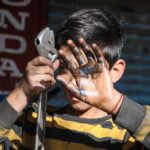
This sub-section refers to persons in forced labour imposed by private actors for commercial sexual exploitation. This category of forced labour includes adults’forced involvement in commercial sexual exploitation, in production of sexual abuse materials, and in new forms of Internet-based commercial sexual exploitation. It also includes all forms of commercial sexual exploitation involving children.
The 2021 Global Estimates indicate a total of 6.3 million people are in situations of forced commercial sexual exploitation on any given day. This number includes 1.7 million children in commercial sexual exploitation, about a quarter of the total. Gender is a critical determining factor – nearly four out of
every five of those trapped in forced commercial exploitation are girls or women.
Information from other sources underscores the close link between forced commercial sexual exploitation and trafficking. According to UNODC, half of all identified trafficking cases reported to the organization in 2018 involved trafficking for the purpose of commercial sexual exploitation. The CTDC also reports large shares of identified cases involving trafficking for sexual exploitation, with some geographic variation.
The trafficking mechanisms can be complex. UNODC, for example, reports multiple cases of collaboration between criminal groups specializing in recruitment and brokering women for commercial sexual exploitation in a source country and other criminal networks specializing in their “reselling” and abuse in destination countries. Traffickers commonly use false promises of other job opportunities abroad – for example, in domestic service – as a ploy to recruit women into situations of forced commercial sexual exploitation. Increasingly, social media and websites are used to recruit people via fake job advertisements.
According to CTDC, victims trafficked for the purpose of sexual exploitation report psychological abuse as the most frequent means by which traffickers control them, followed by restrictions on their freedom of movement and threats being made against them or their loved ones.
The numerous large-scale crises currently unfolding worldwide, and the population displacements and heightened vulnerability associated with them, are creating fertile ground for human traffickers. In Ukraine, for example, international organizations are raising the alarm about the risk of human trafficking and commercial sexual exploitation among the millions of women and children fleeing the conflict there. Similar concerns have been raised in a number of other conflict-related crises, including in Central African Republic, Colombia, Democratic Republic of the Congo, Iraq, Libya, Mali, Myanmar, Somalia, South Sudan, Sudan, Syrian Arab Republic, and Yemen.
from “Global Estimates of Modern Slavery
Forced Labour and Forced Marriage”
© International Labour Organization (ILO), Walk Free, and International
Organization for Migration (IOM) 2022

